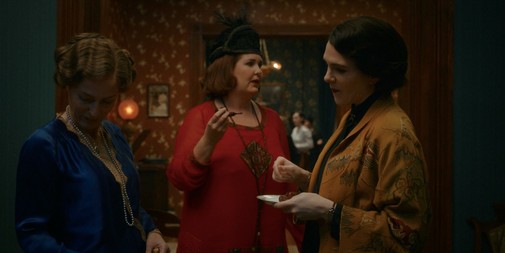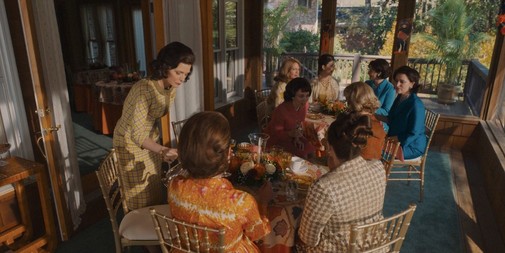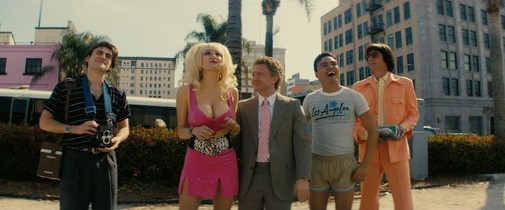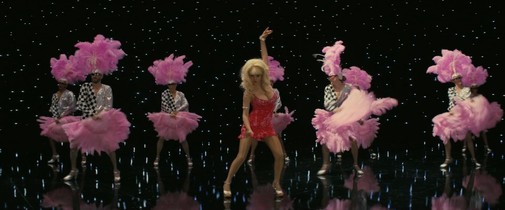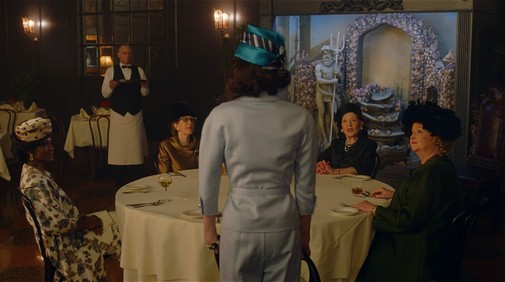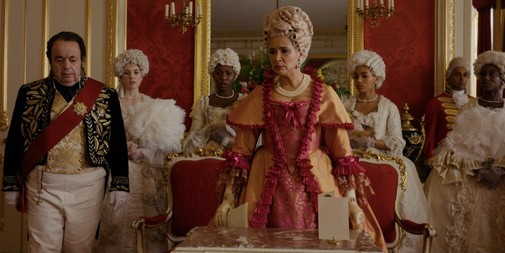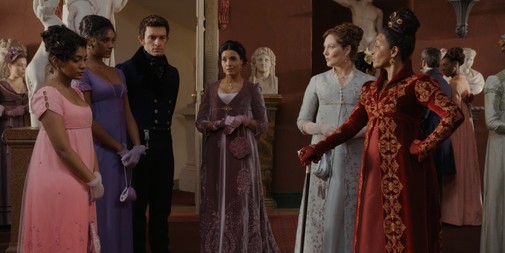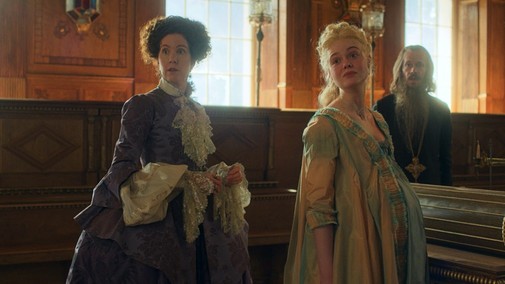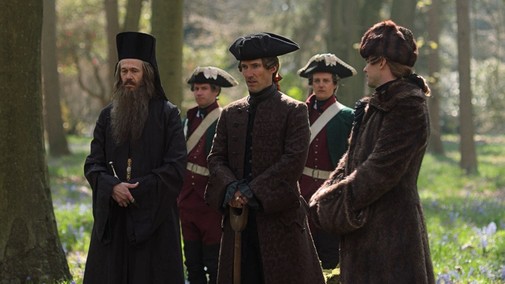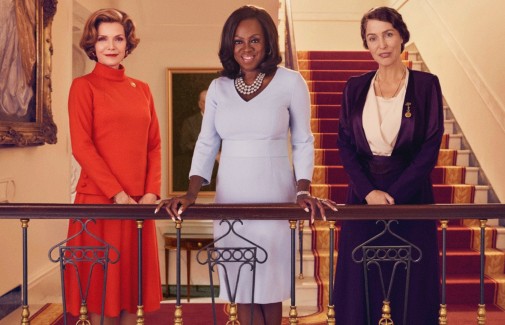
Where is The Gilded Age with its cornucopia of tacky bustle gowns, a good portion of which are copied from fashion plates, museum pieces, and period portraits? Where are Gentleman Jack's precise visions of Romantic dress, queer aesthetics seen through a 19th-century lens? Where are the comedic stylizations of Our Flag Means Death or Julia's purviews of a television icon of days gone by? Where's the love for Schmigadoon!'s cavalcade of hot men in tight pants or Pachinko's cultural delineations rendered in a rainbow of beautiful textiles?
Though the period category for the 2022 Emmys is the most solid of the three costume lineups (we previously discussed contemporary and fantasy fashions), many inspired period possibilities were ignored in favor of repeat contenders and curious flops...
Considering Emmy history, The Marvelous Mrs. Maisel seems poised to win for a second time, while Angelyne and The First Lady are just happy to be there. Taking historical settings as a chance to indulge in deliberate anachronism, The Great and Bridgerton could come out victorious, but their scarcity of additional recognition isn't encouraging, even if the Hulu comedy scored two well-deserved acting nods.
Outstanding Period Costumes
Nominees:
- Danny Glicker, Jessica Fasman & Adam Girardet for Angelyne, Episode: "Glow In the Dark Queen of the Universe" (S01E03)
- Description: Murals, hot seats, centerfolds, movie roles, fresh eyes -- huge, gigantic fame; exposure leaves Angelyne exposed.
- Sophie Canale, Dougie Hawkes, Sarah June Mills, Charlotte Armstrong, Sanaz Missaghian & Kevin Pratten-Stone for Bridgerton, Episode: "Harmony" (S02E07)
- Description: Scandalous rumors swirl around the Bridgertons and the Sharmas. The queen's ire over Lady Whistledown lands Eloise and Penelope in a quandary.
- Signe Sejlund, Felicia Jarvis, Matthew Hemesath, Paula Truman, Stephen Oh & Jessica Trejos for The First Lady, Episode: "Cracked Pot" (S01E04)
- Description: Eleanor discovers Franklin's marital indiscretions, which motivates her to socialize with more independent, politically active women. A stubborn injury drives Betty to seek help from a doctor, who prescribes addictive pain medication. After toddler Sasha is hospitalized, Michelle vows to improve Chicago's inadequate healthcare system.
- Sharon Long, Viveene Campbell, Anna Cavaliere & Bobbie Edwards for The Great, Episode: "Seven Days" (S02E08)
- Description: Elizabeth pronounces that Catherine's baby will be born in five days; the court begins preparations and performs rituals for Peter and Catherine; conflict with the Ottomans heightens, and Catherine tries to run the country while on forced bed rest.
- Donna Zakowska, Moria Sine Clinton, Ben Philipp, Ginnie Patton, Dan Hicks & Mikita Thompson for The Marvelous Mrs. Maisel, Episode: "Maisel vs Lennon: The Cut Contest" (S04E06)
- Description: Word of Midge's act is spreading, attracting a female audience to the Wolford. Columnist L. Roy Dunham continues to trash Midge, leading to a revelation when they meet. The established matchmakers in town warn Rose to stop encroaching on their business. Midge's arch enemy Sophie asks her for a favor.
ANALYSIS:
Starting with the least likely to win, The First Lady got canceled after a lackluster first season and scored only three nominations at this year's Emmys. Though Michelle Pfeiffer's performance makes the Showtime project worth watching, it's hard to argue against the overall fate of the series. Costume-wise, it's an attractive achievement that prioritizes historical accuracy above other concerns while still finding character details through faithful recreation. It's a nifty negotiation of narrative priorities, crucial for a program that attempts – and arguably fails – to juggle the tenets of docudrama with a triple character study.

That tryptic structure may make for a disjointed script, but it does set the stage for a varied showcase of historical costuming. In the submitted fourth episode - a bizarre pick when the previous installment featured three wedding scenes and many more costume changes - designer Signe Sejlund must take Eleanor Roosevelt from 1918 to 1929, starting with the cataclysm of marital strife and the discovery of past infidelities. The color story isn't very complex, highlighting Eleanor's blue mood and reminding us of marriage through bridal whites. Later, during a meeting of queer-friendly suffragettes, the audience sees an array of approaches to women's fashion in the early 20th century, each extra individualized by pointed style choices.
Betty Ford's narrative is less fashion-forward, happening mostly within the sartorially conservative milieu of wealthy suburbia with occasional flashbacks to youthful flirtations with a career in dancing. The contrast between the minimalism of Martha Graham's dance company and Ford's housewife aesthetic is startling. Flashes of orange and the disheveled reveal of rumpled petticoats add to the effect. As for Michelle Obama's scenes, they cut between domestic spaces and the hospital, ranging from comfortable pajamas to professional elegance. It all feels authentic, stemming from thorough research into some of the most photographed women in recent history.

Angelyne also jumps back and forward in time, but its story centers around the titular character and no one else. Still, that's quite a lot of material to work with, especially as the series unfolds and she unravels before our eyes, fantasy and memory, further deepening the viewer's understanding of Angelyne as a self-aware creation cum identity crisis. The third episode sees the early peak of this self-made celebrity during the 80s, while, in 2017, an interviewer digs into who this strange woman really is. Oscar-nominee Danny Glicker explores the limits of camp, the sweet ambrosia of tastelessness, the endless possibilities of pink as a lifestyle more than a color.

For both The First Lady and Angelyne, the costume teams had to contend with the challenges of reproduction, copying exact looks from the annals of history and pop culture. While The Marvelous Mrs. Maisel doesn't go quite as far, it involves some real-life figures, and the protagonist is partly inspired by Joan Rivers. Moreover, its sartorial approach is tightly focused on an accurate representation of the past, delineating a period of transition from 1950s styles to the new decade in fashion. Everyone is impeccably dressed, each extra as perfectly attired as the main players, making crowd scenes especially delicious for costume lovers.
In the selected episode, we also get a good idea of how the costumes are integral to the show's comedic strategy. Though nothing truly crosses the line into modernization, there's a clear appeal to cartoony excess and exaggerated trends. This is noticeable when witnessing a meeting of authoritarian matchmakers, the heightened spectacle of a burlesque show, the absurd contrast of Midge's Hepburn-like elegance, and Sophie Lennon's dominance through ostentation. There's also the opening to consider when a bedraggled Lenny Bruce stands out like a sore thumb amid the Weissman's magazine-ready domesticity.
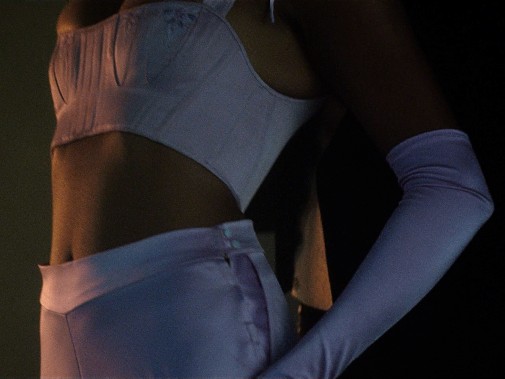
If those three nominees chose the path of historicism, the remaining pair would epitomize a stylized outlook where modern sensibilities dictate how bygone eras are materialized for the small screen. Ellen Mirojnick is no longer leading the Bridgerton costume team, but the pastel prom aesthetic she developed for the first season remains consistent in the series' second year. Everything from textile choices to cut and execution has little to do with reality, evoking a dream of Regency England that never was. I find it all a bit gaudy and unbalanced, even as I recognize this is merely a matter of taste rather than sound criticism.
As in season one, Adjoa Andoh's Lady Danbury is the best-dressed character. The Bridgertons are a nightmare of subdued blues and creams, the Featherington's a migraine-inducing storm of yellow. Queen Charlotte is a walking prochronism, still bedecked in Georgian court fashions while everyone else has moved on beyond paniers and boned stomachers. The Sharmas are a new addition to the cast and tend towards purples, decadent satins that might occasionally look cheap, sometimes sensuous. In the submitted episode, we even get a glimpse at reimagined Regency underwear, short stays transfigured into a structured bralette.
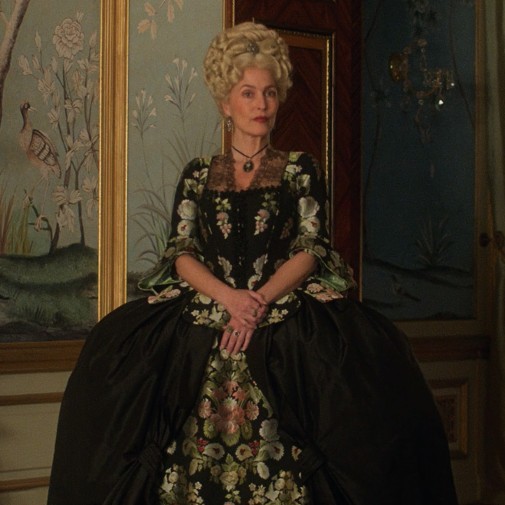
The Great is also on its second season, though its wardrobe has had a more significant glow-up than Bridgerton's. One can feel how the design team found their footing after trial and error, going into wilder extremes of fantasy while indulging in specific idiosyncrasies of Rococo fashions. Indeed, when it came time to choose a submission, there were plenty of great episodes to pick from, including chapters featuring coronations, weddings, and the world's craziest baby shower. Ultimately, The Great went with one of two episodes guest starring Gillian Anderson as Catherine's flirtatious mother – an understandable decision.
Coming from Germany, she's positioned as the show's most fashion-forward character, wearing the widest paniers and taking up space like nobody's business. Her somber, mayhap ominous color palette also highlights the woman's presence, a tragic fate. She's not the only clotheshorse on screen, though. Everyone dresses to impress in The Great, from Catherine's collection of maternity haute couture to Aunt Elizabeth's oddball penchant for masculine cuts and entomological details. The men are no less impressive, especially Nicholas Hoult's deposed emperor, regularly adorned in furs befitting a vicious predator.
Considering Emmy history, The Marvelous Mrs. Maisel is the safe bet for a second win, while Angelyne and The First Lady are just happy to be there. Taking historical settings as a chance to indulge in deliberate anachronism, the showy work of The Great or Bridgerton could come out victorious, but their scarcity of additional recognition isn't encouraging.
Will Win: The Marvelous Mrs. Maisel
Should Win: Angelyne
Spoiler: The Great
Which show are you rooting for?
MORE ANALYSIS
